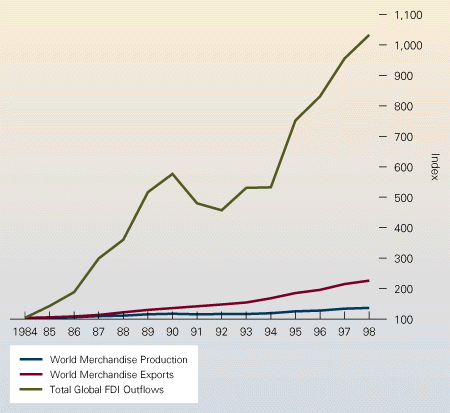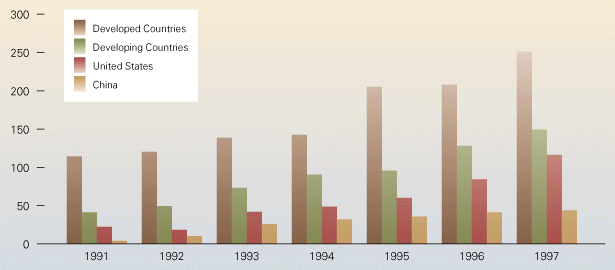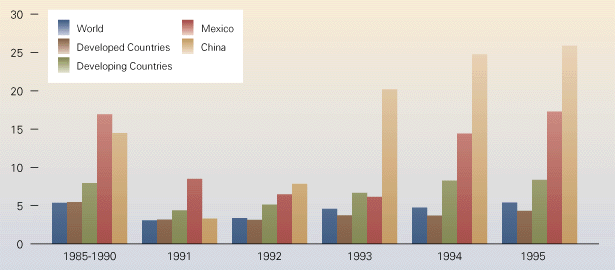Texts belong to their owners and are placed on a site for acquaintance.
Foreign Direct Investment in the World Economy
When discussing foreign direct investment, it is important to distinguish between the flow of FDI and the stock of FDI. The flow of FDI refers to the amount of FDI undertaken over a given time period (normally a year). The stock of FDI refers to the total accumulated value of foreign-owned assets at a given time. We also talk of outflows of FDI, meaning the flow of FDI out of a country, and inflows of FDI, meaning the flow of FDI into a country.
The Growth of FDI
The past 20 years there have seen a marked increase in both the flow and stock of FDI in the world economy. The average yearly outflow of FDI increased from about $25 billion in 1975 to a record $430 billion in 1998 (see Figure 6.1).1 The flow of FDI not only accelerated during the 1980s and 1990s, but it also accelerated faster than the growth in world trade. Between 1984 and 1998, the total flow of FDI from all countries increased by over 900 percent, while world trade grew by 121 percent, and world output by 34 percent (see Figure 6.2).2 As a result of the strong FDI flow, by 1998 the global stock of FDI exceeded $4.0 trillion. In total, 45,000 parent companies had

Figure 6.1
FDI Outflows 1982 - 1998 ($ billions)1
1Note: 1998 data based on preliminary estimates.
Source: United Nations, World Investment report, 1998 (New York and Geneva: United Nations, 1997).
Figure 6.2
Growth of FDI, World Trade, and World Output 1984 - 1998 (Index = 100 in 1984)1
1Note: 1998 data based on preliminary estimates
Source: World Trade Organization, Annual Report, 1998 (Geneva: WTO, 1998), and United Nations, World Investment Report, 1998 (New York and Geneva: United Nations, 1998).

280,000 affiliates in foreign markets that collectively produced an estimated $7 trillion in global sales.3
FDI is growing more rapidly than world trade and world output for several reasons. Despite the general decline in trade barriers that we have witnessed over the past 30 years, business firms still fear protectionist pressures. Business executives see FDI as a way of circumventing future trade barriers. Much of the Japanese automobile companies' investment in the United States during the 1980s and early 1990s was driven by a desire to reduce exports from Japan, thereby alleviating trade tensions between the two nations.
Second, much of the recent increase in FDI is being driven by the dramatic political and economic changes that have been occurring in many of the world's developing nations. The general shift toward democratic political institutions and free market economics that we discussed in Chapter 2 has encouraged FDI. Across much of Asia, Eastern Europe, and Latin America, economic growth, economic deregulation, privatization programs that are open to foreign investors, and the removal of many restrictions on FDI have all made these countries more attractive to foreign investors. According to the United Nations, between 1991 and 1996 over 100 countries made 599 changes in legislation governing FDI. Some 95 percent of these changes involved liberalizing a country's foreign investment regulations to make it easier for foreign companies to enter their markets. The desire of governments to facilitate FDI has also been reflected in a dramatic increase in the number of bilateral investment treaties designed to protect and promote investment between two countries. As of January 1, 1997, there were 1,330 such treaties in the world involving 162 countries, a threefold increase in five years.4
We saw in the opening case how Electrolux has responded to these trends by investing in Eastern Europe and Asia. The acquisition of Lehel of Hungary, for example, was the result of a privatization program that allowed foreign investors to purchase state-owned enterprises.
The globalization of the world economy, a phenomenon that we first discussed in Chapter 1, is also having a positive impact on the volume of FDI. Firms such as Electrolux now see the whole world as their market, and they are undertaking FDI in an attempt to make sure they have a significant presence in every region of the world. For reasons that we shall explore later in this book, many firms now believe it is important to have production facilities based close to their major customers. This, too, is creating pressures for greater FDI.
The Direction of FDI
Not only has there been rapid growth in the flow of FDI, but there has also been an important shift in the direction of FDI. Historically, most FDI has been directed at the developed nations of the world as firms based in advanced countries invested in the others' markets. The United States has often been the favorite target for FDI inflows. This trend continued in 1996 when $84.6 billion was invested in the country (see Figure 6.3). 5 The United States is attractive because of its large and wealthy domestic markets, its dynamic and stable economy, a favorable political environment, and the openness of the country to FDI. Investors have included firms based in the United Kingdom, Japan, Germany, Holland, and France.
While developed nations in general, and the United States in particular, still account for the largest share of FDI inflows, there has been a surge of FDI into the world's developing nations (see Figure 6.3). From 1985 to 1990, the annual inflow of FDI into developing nations averaged $27.4 billion, or 17.4 percent of the total global flow. By 1997, the inflow into developing nations had risen to $149 billion, or 37 percent of the total. The lion's share of the 1997 inflow into developing nations was targeted at the emerging economies of South, East, and Southeast Asia, which collectively accounted for $87 billion of the 1997 total. Driving much of the increase

Figure 6.3
FDI Inflows, 1985 - 1987 ($ billions)
Source: United Nations, World Investment
Report, 1998 (New York and Geneva: United Nations,
1998).
has been the growing importance of China as a recipient of
FDI (see Figure 6.3). In 1997, China received direct investments valued
at $45 billion, making it the second largest recipient of FDI in the world
after the United States. The reasons for the strong flow of investment
into China are discussed in the accompanying Country Focus. Singapore
was the second largest investment recipient in the Asian region, with
inflows valued at $9 billion.
After South, East, and Southeast Asia, Latin America emerged
as the next most important region in the developing world for FDI inflows.
In 1997, total inward investments into this region reached a record $58
billion. About $16 billion of this total was invested in Brazil, with
another $12 billion targeted at Mexico. Much of this investment was a
response to pro-market reforms in the region, including privatization,
the liberalization of regulations governing FDI, and the growing importance
of
Figure 6.4
Inward FDI Flows as a Percentage of Gross Fixed Capital Formation, 1985 - 1995.
Source: Data from United Nations, World Investment Report, 1998 (New York and Geneva: United Nations, 1997).

where FDI inflows accounted for 13.2 percent of all capital investment in 1995, Sweden (42.8 percent in 1995), and Australia (20 percent in 1995). But FDI inflows accounted for less than 0.1 percent of all gross fixed capital formation in the Japanese economy in 1995--a figure that reflects not only the prolonged economic recession in that country, but also the host of formal regulations and informal barriers that make it difficult for foreign companies to invest in and do business in this nation. South Korea, which historically modeled itself on Japan, also has a low level of FDI as a percentage of capital formation (1.1 percent in 1995). To the extent that capital inflows allow a country to achieve higher future growth rates, countries such as Japan and South Korea may be hurting themselves by adopting restrictive regulations with regard to FDI inflows. We shall return to this issue in the next chapter.
The Source of FDI
Since World War II, the United States has traditionally been by far the largest source country for FDI. During the late 1970s the United States was still accounting for about 47 percent of all FDI outflows from industrialized countries, while the second-place United Kingdom accounted for about 18 percent. US firms so dominated the growth of FDI in the 1960s and 70s, that the words American and multinational became almost synonymous. As a result, by 1980, 178 of the world's largest 382 multinationals were US firms, and 40 of them were British.6 As Figure 6.5 illustrates, however, during the 1985 - 90 period, the United States slipped to third place behind Japan and the United Kingdom. Since then, the United States has regained its dominant position, accounting for $116.5 billion of FDI outflows, or 29 percent of the global total, in 1997. After a surge during the 1980s, FDI by Japanese firms has slipped, accounting for only 6.4 percent of the global total in 1997, down from 21 percent in 1990.
The increase in Japanese FDI outflows during the 1980s and the subsequent stagnation during the 1990s reflect the strong Japanese economy during the 1980s and the prolonged recession that gripped the economy during the 1990s. During the 1980s, Japanese firms were making market share gains in industry after industry. This yielded strong growth in profits and cash flows. In addition, the Japanese currency increased in value against many other currencies during this period, including the US dollar. Data from J. P. Morgan suggest that an index measuring the value of the Japanese yen against 44 other currencies increased from 89.2 in January 1980 to a high of 130.4 in August 1993 (the index was set to 100 in 1990).7 As the yen became more valuable, it became progressively cheaper to acquire assets in countries whose currencies were not as strong, such as the United States. Thus, the combination of strong growth in corporate profits and cash flows and a strong currency made it both easy and relatively inexpensive for Japanese firms to purchase the assets--including factories, land, office buildings, and often whole firms--in countries whose economic performance was less robust and whose currency was weaker. Also, in many countries there was an increased threat that trade barriers might be put in place to hold back the growing flood of Japanese exports (this was certainly true in the United States). This gave many Japanese firms a strong incentive to invest in production facilities overseas and serve foreign markets from those facilities, as opposed to exporting from Japan. In sum, a strong corporate performance, a strong currency, and the threat that foreign countries might erect trade barriers against Japanese exports all created a climate that helped propel Japanese FDI outflows to record levels from 1985 to 1991. The slowdown in the growth of Japanese FDI outflows since 1991 simply reflects the poor corporate performance in Japan that is the result of the country's economic malaise.
The growth of FDI outflows from the United States has been driven by a combination of favorable factors including a strong US economy, strong corporate profits and cash flow--which have given US firms the capital to invest abroad--and a relatively strong currency, particularly since 1995. Similar factors explain the continued growth of FDI outflows from the United Kingdom during the 1990s.
The other notable trend in the statistics summarized in Figure 6.5 has been the rise of FDI outflows from developing nations. These have increased from an annual average of $10.5 billion from 1985 to 1990 to a record $55 billion in 1997. The biggest investors among developing nations in 1996-97 were Hong Kong, Singapore, and South Korea. Much of the Hong Kong and Singapore investment was targeted at China and other Southeast Asian nations. While Korean firms also invested in these regions, they also targeted the United States and Europe. Such investments in 1996 propelled Daewoo of South Korea to number 52 on the list of the 100 largest multinational corporations in the world, as measured by asset value. Although the 1997/98 financial crisis in Southeast Asia caused a near-term slowdown in the investment outflow from these nations, in the long run the flow of FDI from developing nations will likely keep pace with the underlying growth in their economies.